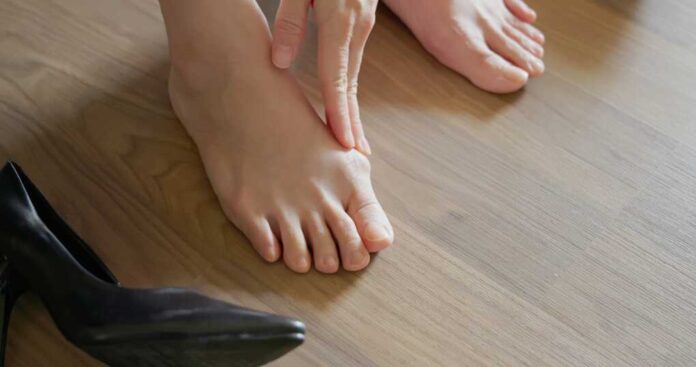
Bunions affect one-third of Americans of all ages and genders, yet many sufferers don’t seek treatment due to misconceptions about causes and available solutions.
At a Glance
- Bunions are complex bone deformities at the base of the big toe, not just cosmetic issues or callouses
- Contrary to popular belief, genetics plays a larger role than high heels in bunion development
- Risk factors include family history, gender (more common in women), certain foot types, and arthritis
- Treatment options range from conservative approaches like proper footwear to various surgical procedures
- Early intervention is important as bunions are progressive and don’t resolve without treatment
Understanding What Bunions Really Are
Bunions, medically known as hallux valgus, are progressive bone disorders that affect the joint at the base of the big toe. The condition causes the big toe to angle inward toward the other toes, creating a bony bump on the side of the foot. A similar condition called bunionettes or “tailor’s bunions” can form on the outside of the foot near the little toe. These deformities develop gradually over time as pressure on the joint causes the big toe to drift out of alignment.
The condition affects approximately one-third of Americans, with about three million new cases reported annually in the U.S. Doctors typically categorize bunions into two types: genetic (inherited foot structure) and acquired (developed due to external factors). When the condition occurs in younger people, particularly girls between ages 10-15, it’s specifically referred to as adolescent bunions, which may still allow for normal toe movement despite the deformity.
Debunking Common Bunion Myths
One of the most persistent misconceptions about bunions is that they primarily affect older women who wear high heels. While improper footwear can certainly contribute to bunion development and progression, the underlying causes are more complex. Genetics plays a significant role, with more than 70% of people with bunions having a biological parent with the same condition. This hereditary component often determines foot structure and mechanics that predispose individuals to bunion formation.
Other significant risk factors include certain types of arthritis (particularly rheumatoid arthritis), foot mechanics such as overpronation (rolling inward when walking), previous foot injuries, and congenital foot deformities. Bunions are also more common in women than men, which may be partly due to differences in foot structure and footwear choices, but genetic factors still play the primary role in determining who develops this condition.
Recognizing Symptoms and Complications
Early recognition of bunion symptoms is crucial for effective management. Common signs include a visible bony bump at the base of the big toe, persistent pain and swelling around the joint, redness and thickened skin at the base of the big toe, and the big toe pointing toward the other toes. Many people first notice problems when they experience difficulty finding comfortable shoes or pain while walking. As the condition progresses, corns and calluses may develop where toes overlap.
If left untreated, bunions can lead to serious complications. The altered foot mechanics can cause persistent pain that makes walking difficult. The big toe joint may develop arthritis as the protective cartilage wears away from abnormal pressure and friction. In advanced cases, the overlapping toes can develop corns, calluses, and hammertoe deformities. Some people experience significant limitation in activities and reduced quality of life due to chronic pain and mobility issues.
Treatment Approaches: From Conservative to Surgical
Treatment for bunions typically begins with conservative approaches aimed at relieving symptoms and preventing progression. These include switching to properly fitting shoes with a wide toe box and low heels, using protective padding or spacers between toes, wearing custom orthotic devices to correct foot mechanics, applying ice to reduce inflammation, and taking over-the-counter pain medications. Physical therapy exercises may help maintain joint mobility and strengthen surrounding muscles.
When conservative measures fail to provide relief, surgical intervention may be necessary. Multiple surgical approaches exist, including bunionectomy (removal of the bunion bump), osteotomy (cutting and realigning the bone), arthrodesis (fusing joints), and newer procedures like lapiplasty that address the root cause of the deformity. Recovery from bunion surgery typically takes 6 weeks to 6 months, with swelling potentially lasting up to a year. The specific procedure recommended depends on the severity of the deformity, age of the patient, and other health factors.
Prevention and Long-Term Management
While genetic predisposition can’t be changed, several strategies may help prevent bunion development or slow progression. Maintaining a healthy weight reduces pressure on feet. Choosing appropriate footwear with adequate toe space, arch support, and proper fit is essential. Avoiding high heels and pointed toe boxes minimizes abnormal forces on the big toe joint. Custom orthotics can help correct mechanical issues like overpronation that contribute to bunion formation.
For those already diagnosed with bunions, regular monitoring by a podiatrist or orthopedic specialist is important. Even with proper management, bunions may continue to progress over time, requiring adjustment of treatment approaches. Early intervention often provides the best outcomes, allowing for less invasive treatments and better preservation of joint function. Most people can successfully manage bunion symptoms with appropriate care, though severe cases may ultimately require surgical correction for optimal function and comfort.


















